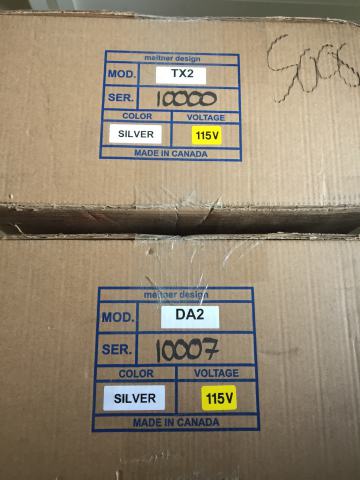In 1973, I bought an Audi Fox. One of the earliest models made that were brought into the US.. It wasn't long before I learned never to do that again. Not only did water leak into the cabin through the air conditioning vents when going through the car wash, but the back seat spontaneously burst into flames one day. My new Meitner units are surely some of the earliest made (#1 for the transport?), and lessons of the Audi Fox have apparently been forgotten. I opened the boxes and set up the units and lo and behold, they worked. That's the good news. Since my units are in a cabinet, I use LED emitters over the infrared sensors that are commonplace on the front panels of many pieces of audio/video gear. The next 4 ours were na exercise in total frustrations as I could not get the units to work remotely using their remote unless I stood right in front of the units. To begin, when I called Meitner they told me that the sensors were smack dab in the middle (both horizonatally and vertically) of the display panel. They are not. Then they told me I had the emitters mounted incorrectly on the panel. Instead of placing the flat side of the plastic housing the LED on the glass planel, they told me to turn it around since the LED is meant to shine through the bubble round top. I asked them if they were kidding and reminded them I was using the same damn sense that i used on the XDS!v2 that these units replaced. They replied that the bubble side of the sensor is the side that allows the light to be seen. Again I asked what they were smoking since the light can easily be seen coming form the flat bottom as well as the round part of the LED diode housing. After a good deal of struggling and a good deal of frustration after my realization that they never tested these iunit wtih any LED emitters that are commonly used by audiophiles, I discovered the answer myself. It turns out the emitter receivers are at the very very top of the display glass, so near the edge that the only way to get the emitter to work is to mount them sideways!! Next, I have to tell you the display on the DAC is just fine because you can control the brightness as well as the contrast so you can get crisp white letters on a black background. Bot so for the matching transport, which only has a brightness control. No matter what brightness is chosen, the display panel looks terrible. It is in fact the worst digital display I have ever seen, with background streaks, lines, splotches and blotches that no doubt occurs as a result of not being to adjust the contrast. The net result is that I am now the proud owner of a matching set of transport and dac with displays that don't look the same at all. One looks good, the other looks like crap. I've learned that the only way the transport display looks good is when you turn it off! At least they allow me to do that!
Folks, with all of the problems in the world and in all our lives, I am truly embarrassed to cry about the poor problems I encountered with a new pair of audio components that cost as much as a nice car. But I am pissed. What's worse, this is my 4th piece of Meitner gear and this story isn't that different to my previous experiences with their great. To be blunt, their quality control is just not very good, and moreover, they provided me with misinformation when I called them to try and figure out the problem. I know the definition of insanity is doing the same thing over and over and expecting a different result, but I just can't myself with Meitner. He makes sonically exceptional gear. ''i truly hope this unit is no different. I've been a Meitner guy for along time because of the fact that to my ears, his top end, in particular, is the most natural and analogue sounding of all the devices I have heard so I am sticking with the "Meitner sound". I will certainly hope that the unit breaks in and performs as expected, and my guess is that it will. But I have to tell you, I have zero joy or pride of ownership in owning his expensive gear. Never have. Rather, it's all about the sound. How does that nursery rhyme go "...and when he was good, he was very very good, and when he was bad he was horrid". So has it been my experience with EMM labs.

















